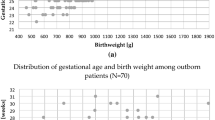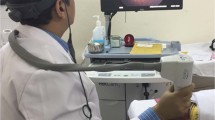Abstract
Purpose
Retinopathy of prematurity (ROP), a proliferative vitreoretinopathy resulting from the vascular disorder of the retina, is the most frequent cause of blindness in childhood. In our time, ROP in advanced stage, a serious problem in premature infants, has no other treatment more effective and with fewer side effects than laser photocoagulation (LPC) treatment, which narrows visual field. The search for methods with fewer side effects than LPC has increased in recent times for the treatment of ROP. We aimed to investigate the effects in question of propranolol on ROP in various stages (stages 1, 2, and 3 ROP).
Methods
This study is designed as a randomized, placebo-controlled, single-centered, double-blind clinical trial with parallel groups. A total of 126 very preterm infants, followed up in our unit from April 2011 to January 2013, were randomly selected and included in our study. They were separated into the groups of 0, 1, and 2 depending on their stage of ROP. In addition, all the patients were divided into control group (CG) and propranolol treatment group (PTG). While the cases in the CG were administered physiological saline solution, the cases in the PTG were administered propranolol (2 mg/kg/day) in the neovascularization phase (second phase) of the ROP.
Results
Propranolol given to the group of stage 0–1 ROP was observed to have had no effect on the level of statistical significance between the CG and PTG in terms of increase in ROP stages (p > 0.05). However, propranolol was found to be more useful in patients with stage 2 ROP (p < 0.05).
Conclusion
When given in the neovascularization phase of the ROP, propranolol was found to be effective in the stage 2 (advanced stage) ROP patients but in stage 0–1 (early-stage) ROP patients, its efficacy was not sufficient.

Similar content being viewed by others
References
Fierson WM (2013) American Academy of Pediatrics Section on Ophthalmology; American Academy of Ophthalmology; American Association for Pediatric Ophthalmology and Strabismus; American Association of Certified Orthoptists. Screening examination of premature infants for retinopathy of prematurity. Pediatrics 131:189–195
Ristori C, Filippi L, Dal Monte M, Martini D, Cammalleri M, Fortunato P et al (2011) Role of the adrenergic system in a mouse model of oxygen-induced retinopathy: antiangiogenic effects of beta adrenoreceptor blockade. Invest Ophthalmol Vis Sci 52:155–170
Martini D, Monte MD, Ristori C, Cupisti E, Mei S, Fiorini P et al (2011) Antiangiogenic effects of β2-adrenergic receptor blockade in a mouse model of oxygen-induced retinopathy. J Neurochem 119:1317–1329
Korkmaz L, Baştuğ O, Ozdemir A, Korkut S, Karaca C, Akin MA et al (2016) The efficacy of propranolol in retinopathy of prematurity and its correlation with the platelet mass index. Curr Eye Res 3:1–10
Fleck BW (2013) Management of retinopathy of prematurity. Arch Dis Child Fetal Neonatal Ed 98:454–456
Rathi S, Jalali S, Patnaik S, Shahulhameed S, Musada GR, Balakrishnan D et al (2017) Abnormal complement activation and inflammation in the pathogenesis of retinopathy of prematurity. Front Immunol 22(8):1868
Chan-Ling T, Gole GA, Quinn GE, Adamson SJ, Darlow BA (2018) Pathophysiology, screening and treatment of ROP: a multi-disciplinary perspective. Prog Retin Eye Res 62:77–119
Ng EY, Connolly BP, McNamara JA, Regillo CD, Vander JF, Tasman W (2002) A comparison of laser photocoagulation with cryotherapy for threshold retinopathy of prematurity at 10 years: part 1. Visual function and structural outcome. Ophthalmology 109:928–934
Erbay A, Sarialioglu F, Malbora B, Yildirim SV, Varan B, Tarcan A et al (2010) Propranolol for infantile hemangiomas: a preliminary report on efficacy and safety in very low birth weight infants. Turk J Pediatr 52:450–456
Chen ML, Guo L, Smith LE, Dammann CE, Dammann O (2010) High or low oxygen saturation and severe retinopathy of prematurity. Pediatrics 125:1483–1492
American Academy of Pediatrics (1984) An international classification of retinopathy of prematurity. Pediatrics 74:127–133
Fleck BW, McIntosh N (2009) Retinopathy of prematurity: recent developments. NeoReviews 10:e20–e30
Early Treatment For Retinopathy of Prematurity Cooperative Group (2003) Revised indications for the treatment of retinopathy of prematurity: results of the early treatment for retinopathy of prematurity randomized trial. Arch Ophthalmol 121:1684–1694
Jobe AH, Bancalari E (2001) Bronchopulmonary dysplasia. Am J Respir Crit Care Med 163:1723–1729
Volpe JJ (2001) Neurology of the newborn, 4th edn. WB Saunders, Philadelphia
Bell MJ, Ternberg JL, Feigin RD (1978) Neonatal necrotizing enterocolitis. Therapeutic decisions based upon clinical staging. Ann Surg 187:1–7
Töllner U (1982) Early diagnosis of septicemia in the newborn. Clinical studies and sepsis score. Eur J Pediatr 138:331–337
Kuriyama H, Waki M, Nakagawa M, Tsuda M (2001) Involvement of oxygen free radicals in experimental retinal ischemia and the selective vulnerability of retinal damage. Ophthalmic Res 33:196–202
Montero JA, Ruiz-Moreno JM, Sanchis-Merino E, Perez-Martin S (2013) Systemic beta-blockers may reduce the need for repeated intravitreal injections in patients with age-related macular degeneration treated by bevacizumab. Retina 33:508–512
Smith LE (2008) Through the eyes of a child: understanding retinopathy through ROP the Friedenwald lecture. Invest Ophthalmol Vis Sci 49:5177–5182
Chen J, Connor KM, Aderman CM, Willett KL, Aspegren OP, Smith LE (2009) Suppression of retinal neovascularization by erythropoietin siRNA in a mouse model of proliferative retinopathy. Invest Ophthalmol Vis Sci 50:1329–1335
Filippi L, Cavallaro G, Fiorini P, Daniotti M, Benedetti V, Cristofori G et al (2010) Study protocol: safety and efficacy of propranolol in newborns with Retinopathy of Prematurity (PROP-ROP): ISRCTN18523491. BMC Pediatr 18(10):83
Blair BM, O’halloran HS, Puly TH, Stevens JL (2001) Decreased incidence of retinopathy of prematurity. J AAPOS 5:118–122
Chen ML, Allred EN, Hecht JL, Onderdonk A, VanderVeen D, Wallace DK et al (2011) ELGAN Study. Placenta microbiology and histology and the risk for severe retinopathy of prematurity. Invest Ophthalmol Vis Sci 52:7052–7058
Higgins RD, Mandelsohn AL, DeFeo MJ, Ucsel R, Hendricks-Munoz KD (1998) Antenatal dexamethasone and decreased severity of retinopathy of prematurity. Arch Ophthalmol 116:601–605
Haigh JJ, Morelli PI, Gerhardt H, Haigh K, Tsien J, Damert A et al (2003) Cortical and retinal defects caused by dosage-dependent reductions in VEGF-A paracrine signaling. Dev Biol 262:225–241
Gibbs ME, Hutchinson DS, Summers RJ (2010) Noradrenaline release in the locus coeruleus modulates memory formation and consolidation; roles for a- and β-adrenergic receptors. Neuroscience 170:1209–1222
Sullivan RM, Wilson DA, Leon M (1989) Norepinephrine and learning-induced plasticity in infant rat olfactory system. J Neurosci 9:3998–4006
Dal Monte M, Casini G, la Marca G, Isacchi B, Filippi L, Bagnoli P (2013) Eye Drop propranolol administration promotes the recovery of oxygen-induced retinopathy in mice. Exp Eye Res 111:27–35
Filippi L, Cavallaro G, Berti E, Padrini L, Araimo G, Regiroli G et al (2017) Study protocol: safety and efficacy of propranolol 0.2% eye drops in newborns with a precocious stage of retinopathy of prematurity (DROP-ROP-0.2%): a multicenter, open-label, single arm, phase II trial. BMC Pediatr 17:165
Author information
Authors and Affiliations
Corresponding author
Ethics declarations
Conflict of interest
The authors have no conflict of interest.
Informed consent
This study was approved by the Erciyes University ethical committee, Turkey. Written informed consent was obtained from the parents.
Rights and permissions
About this article
Cite this article
Ozturk, M.A., Korkmaz, L. The efficacy of propranolol in very preterm infants at the risk of retinopathy of prematurity: Which newborn and when?. Int Ophthalmol 39, 1921–1930 (2019). https://doi.org/10.1007/s10792-018-1018-8
Received:
Accepted:
Published:
Issue Date:
DOI: https://doi.org/10.1007/s10792-018-1018-8




